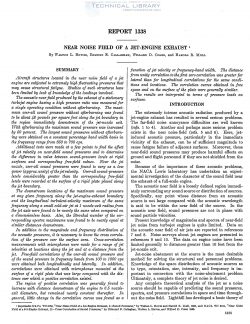naca-report-1338
- Version
- 135 Downloads
- 2.53 MB File Size
- 1 File Count
- November 2, 2016 Create Date
- November 2, 2016 Last Updated
National Advisory Committee for Aeronautics, Report - Near Noise Field of a Jet Engine Exhaust

Aircraft structures located in the near noise field of a jet
engine are subjected to extremely high fluctuating pressures that
may cause structural fatigue. Studies of such structures have
been limited by lack of knowledge of the loadings involved.
The acoustic near field produced by the exhaust of a stationary
turbojet engine having a high pressure ratio was measured for
a single operating condition without afierburning. The maxi-
mum over-all sound pressure without afierburning was found
to be about 42? pounds per square foot along the jet boundary in
the region immediately downstream of the jet-nozzle exit.
With afterburning the maximum sound pressure was increased
by 50 percent. The largest sound pressures without afterburn—
ing were obtained on a constant percentage band width basis in
the frequency range from 350 to 700 cps.
Additional tests were made at a few points to find the effect
of jet velocity on near-field sound pressures and to determine
the difference in value between sound-pressure levels at rigid
surfaces and corresponding free—field values. Near the jet
nozzle, over-all sound pressures were found to vary as a low
power (approx. unity) of the jet velocity. Over-all sound—pressure
levels considerably greater than the corresponding flee-field
levels were recorded at the swface of a rigid plate placed along
the jet boundary.
The downstream locations of the maximum sound pressure
at any given frequency along the jetrengine-exhaust boundary
and the longitudinal turbulent-velocity maximum of the same
frequency along a small cold-air jet at I nozzle-emit radius from
the jet amis were found to be nearly the same when compared on
a dimensionless basis. Also, the Strouhal number of the cor— .
responding spectra maximums was found to be nearly equal at
similar distances downstream.
In addition to the magnitude and frequency distribution of
the acoustic pressures, it is necessary to know the cross correla-
tion of the pressure over the surface area. Cross-correlation
measurements with microphones were made for a range of jet
velocities at locations along the jet and at a distance from the
jet. Free—field correlations of the over-all sound pressure and
of the sound pressure in frequency bands from 100 to 1000 cps
were obtained both longitudinally and laterally. 'In addition,
correlations were obtained with microphones mounted at the
surface of a rigid plate that was large compared with the dis—
tance over which a positive correlation waisted.
| File | Action |
|---|---|
| naca-report-1338 Near Noise Field of a Jet Engine Exhaust.pdf | Download |

Comment On This Post